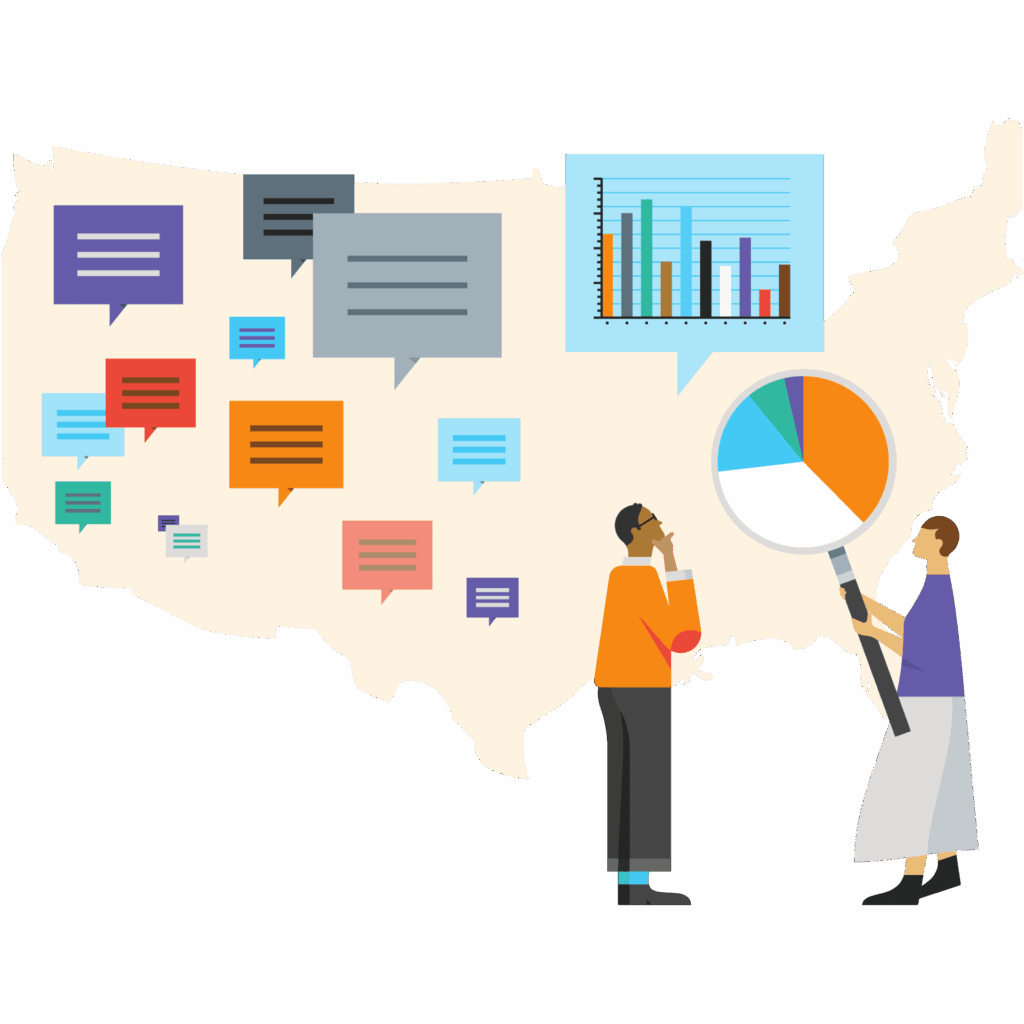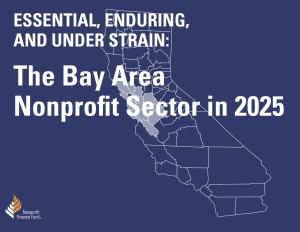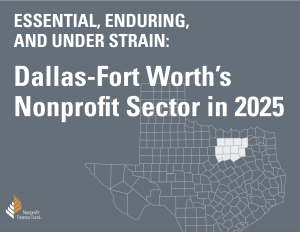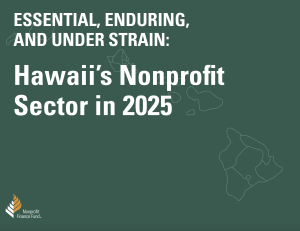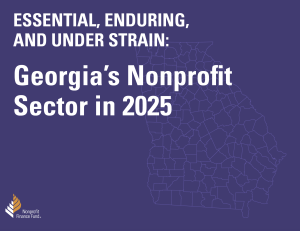The State of the Nonprofit Sector Survey gives a vital look into the financial and operational realities nonprofits face. By listening to nonprofit leaders nationwide, we surface the challenges, trends, and opportunities shaping the sector.
In the 2025 survey, NFF took a look at the data from specific geographies to understand regional trends and nuances. Want to get a sense of how nonprofits in one region are faring financially? Or learn whether government payments to nonprofits in one of these areas are more or less delayed than in the rest of the country? Browse through each regional report for additional insights from the survey data:
- California with a spotlight on:
- Dallas Fort-Worth
- Georgia
- Hawaii
- New York City
- Greater Philadelphia
Bay Area
Nonprofits across the Bay Area are essential to the region’s social and economic fabric – responding, serving, creating jobs, and advocating in communities from San Jose to Sonoma. In 2025, they face mounting pressures: nearly 90% of Bay Area respondents with government funding expect it to decrease, and 93% cite the high cost of living as a management challenge. 40% ended last year with an operating deficit. Yet local nonprofits remain resilient, building community wealth and powering local economies through bold leadership and deep community roots.
“[Our organization] is working to solve problems of equity in business ownership for women, immigrants, and people of color. Women account for only 33% of business owners nationwide and still make 46-75 cents for every dollar their white, male counterparts make. We provide affordable commercial kitchen space to talented entrepreneurs. The high cost of renting a commercial kitchen makes it difficult for many working-class food entrepreneurs to formalize their business. Our kitchen space lets people who were formerly shut out of the food industry find a way in. Businesses receive mentorship and access to market opportunities … ”
Economic development survey respondent in the Bay Area
The Bay Area report was made possible by the Walter & Elise Haas Fund.
Los Angeles County
Los Angeles nonprofits care for us during local crises like devastating wildfires. They protect us, house us, feed us, teach us, and make LA strong and vibrant. And they are doing this in a highly uncertain environment, as LA residents face the impact of extreme weather events, changes to immigration laws and policies, and high inflation in an already high-cost city and county. Just 40% of LA nonprofits were able to pay all staff a living wage in 2024. Learn more about how LA nonprofits are serving their communities, and the challenges they are facing.
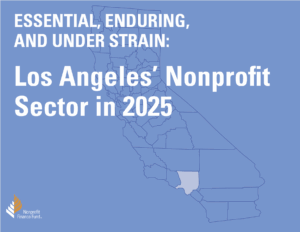
“We have accomplished [our] mission over the last 43 years through a community development model. This model has taken many forms, but one thing has remained the same: We only offer programs the community asks for. With this model, we have always taken a ‘ground-up’ approach to our programming instead of a ‘top-down model’, telling the community what they need to thrive. We understand that the best solutions for a community come from the people most deeply affected by the problems facing that community.”
Youth services survey respondent in LA
The Los Angeles report was made possible by Center for Nonprofit Management.
Dallas Fort-Worth
Across the Dallas-Fort Worth (DFW) region, nonprofits are not just service providers – they are community anchors, economic drivers, and agents of change. But in 2025, they’re navigating a tough landscape: 38% ended last year with a deficit, and nearly half say they won’t be able to meet rising service demand in 2025. Many are struggling to pay staff a living wage and offer basic benefits like health insurance. Despite these pressures, DFW nonprofits remain deeply rooted in their communities, working every day to build a stronger region for all. Check out the DFW report below, including a closer look at Tarrant County.
“[Our organization] plays a vital role in the economic revitalization of our city by creating jobs, stimulating local businesses, and attracting tourism through the restoration [project]. The project generates construction and permanent employment opportunities while fostering workforce development in creative industries. By bringing performances and cultural events to the area, [the organization] increases foot traffic to nearby businesses, supporting economic growth. Additionally, its investment in mixed-use housing and neighborhood improvements helps stabilize property values and encourage further development.”
Arts/culture survey respondent in DFW
The Dallas-Fort Worth report was made possible by Charles Schwab Bank, as well as Communities Foundation of Texas, North Texas Community Foundation, and United Way of Metropolitan Dallas.
Hawaii
Hawaii’s nonprofits are deeply rooted in community, culture, and care – serving as essential infrastructure across the islands. In 2025, they face rising demand and economic pressures: 61% say they won’t be able to meet service demand this year, and 73% report difficulty raising unrestricted revenue. Despite these challenges, Hawaii nonprofits show signs of financial resilience, with only 22% reporting a deficit in 2024 – far lower than the deficit rate reported by nonprofit nationally. Their work spans education, environment, health, and justice, and is powered by leaders who reflect the communities they serve.
“One of our key management challenges is maintaining consistent funding and staffing capacity to meet the growing demand for our services. While we’ve successfully secured grants and donor support, the limited availability of core staff [and] volunteers who are committed ... makes it challenging to scale our programs effectively. ... Improving volunteer retention and building a stronger pipeline for consistent funding are critical to addressing this challenge.”
Youth services survey respondent in Hawaii
The Hawaii report was made possible by Hawai’i Alliance of Nonprofit Organizations.
Georgia
Georgia’s nonprofit sector is a powerful force for community well-being and economic vitality. In 2025, nonprofits across the state are rising to meet growing demand despite financial strain, workforce challenges, and funding delays. These organizations are deeply embedded in their communities – serving, employing, advocating, and innovating. Yet 38% ended 2024 with a deficit – and many don’t have the resources on hand to manage emergencies or invest in their futures. Learn more about the Georgia nonprofit sector, including data snapshots from four Georgia regions, in the full report below.
“[We] uniquely contribute to the community through a blend of artistic excellence and social advocacy … Through music, we tell stories of love, resilience, and empowerment, fostering a greater understanding among audiences of different backgrounds…At the heart of our mission is a commitment to social equity. We use our platform to raise awareness and advocate for equality, offering our support to marginalized groups ... In summary, our "special sauce" is the harmonious combination of artistic expression, community engagement, and advocacy, all aimed at inspiring social change and fostering unity through music.”
Arts/culture survey respondent in Georgia
The Georgia report was made possible by Betty and Davis Fitzgerald Foundation, Community Foundation for Greater Atlanta, The Imlay Foundation, Tull Charitable Foundation, and United Way of Greater Atlanta.
New York City
Across the five boroughs of New York City, nonprofits are working tirelessly to serve, respond, care for, and inspire – while also building community wealth and well-being and contributing to the local economy. But as costs rise, funding declines, and demand for services grows, NYC survey respondents describe a challenging financial picture, with 40% operating with a budget deficit in 2024. For the many local nonprofits with government funding, payment delays are hindering their ability to operate, adapt, and provide critical services to NYC communities.
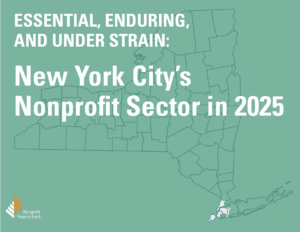
“[Our special sauce] lies in our deeply rooted, community-first approach, with a unique blend of housing advocacy, youth development, and culturally responsive support that has been shaped by over 60 years of grassroots work. … We’re not just advocates; we’re neighbors. We live the challenges we work to address.”
Human services survey respondent in New York City
Greater Philadelphia
Nonprofits in Greater Philadelphia are the vital infrastructure supporting strong and vibrant communities. Survey respondents, along with a dozen local leaders we interviewed, shared stories of how they are pivoting, innovating, and collaborating to best serve their clients in the midst of inflation, funding pullback, and growing demand and uncertainty in their communities. Many local nonprofits are also navigating government payment delays and facing challenges with burnout and employing enough staff.
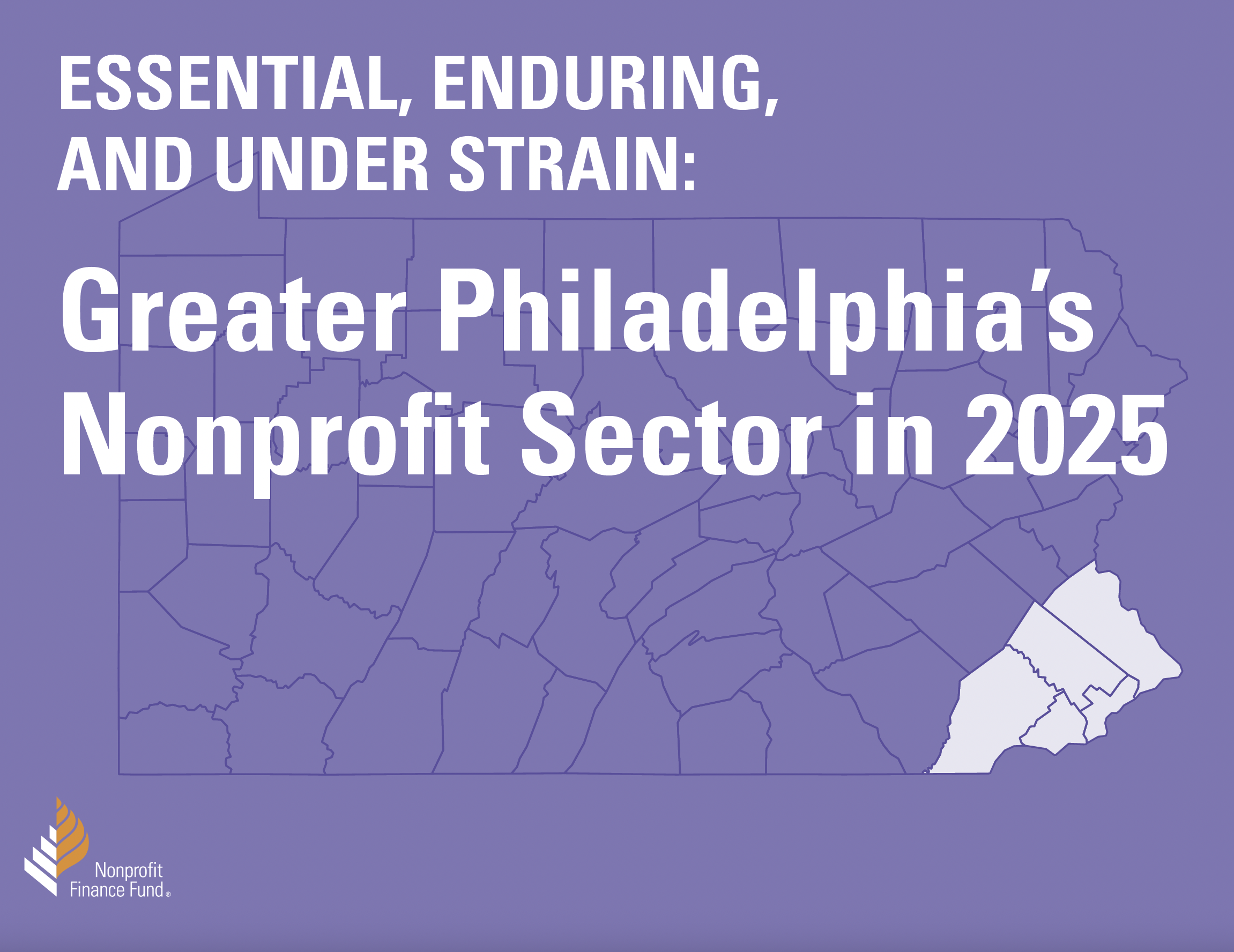
“There is something about this pride of being a part of Philly. And the deep community roots. Nonprofits do the work with a lot of passion. And that helps in a space like now, where we are all facing a similar crisis. Our passion is keeping us grounded and not allowing us to lose hope, even in a time that feels so hopeless.”
Nonprofit interviewee in Greater Philadelphia
The Greater Philadelphia report was made possible by ten local philanthropies committed to ongoing collaboration and co-funding initiatives that address issues of importance to city and region.
